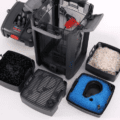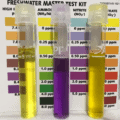When it comes to saltwater aquarium filtration, at times you need more than the regular protein skimmer to get rid of all the pollutants.

Here’s a quick scenario: you realize the phosphate level is high and it’s causing severe algae outbreaks, so you’re on the lookout for a GFO media reactor that will suit your marine tank best and help you in gaining back control.
That said, I want to address many of the common concerns related to media reactors that come my way from various aquarists.
One of the more common questions is related to how effective will the reactor unit be in removing phosphate?
Will the media reactor be sufficient on its own, or do you need a separate pump to run it properly?
And once you have settled on the product, what brand will work best as GFO media for removing persistent pollutants? Would the GFO granules work properly if you also stick activated carbon in the same reactor or does it need to have a separate canister for that?
After all, a single-chamber reactor is twice as compact in the sump.
Speaking of size, is there a nano piece of equipment suitable for a small saltwater aquarium? How about when money is limited – is there a cheap alternative for a reef tank on a budget?
See, the long and the short of this matter is that for the best level of filtration and control of phosphate and other unwanted pollution you’ll need to make an adequate choice of a carbon and/or GFO reactor.
No compromise on that.
Let’s get to it.
You can find a compiled overview chart of the best GFO media reactors here:
| Reactor name: | Recommended for: | Price Bracket: |
|---|---|---|
| 1. Two Little Fishies Phosban Filter Media Reactor | up to 90-gallon tanks | $ |
| 2. Reef Octopus Media Filter w/ Pump | 75 to 200-gallon tanks | $$$ |
| 3. AquaMaxx Fr-se Hang-On Reactor | 55, 75, and 90-gallon tanks | $$ |
| 4. Accel Aquatics Fr-30 | 55 to 150-gallon tanks | $$ |
| 5. Innovative Marine Minimax Pro – Desktop | up to 40-gallon tanks | $ |
| 6. Aquatop | for up to 120-gallon tanks tanks | $ |
The above comes in handy when all you need is not the nitty-gritty, but a quick, summed-up presentation.
What to look for when considering a purchase
It’s not enough to realize you finally need a GFO or carbon media reactor.
I point this out because every aquarium is unique (in terms of water parameters, bio-load, size, etc.).
So I have assembled a list of fundamental points you can use as a guideline while zeroing on the right media reactor to buy.
Here is what to look for in a GFO reactor:
1. Size and Shape
Here is what to consider when deciding the right size for your Granular Ferric Oxide reactor:
Usually, aquarium owners keep the media reactors in the sump.
It’s an easy way to hide the extra equipment.
Consider available space there, before going for a large-size GFO unit.
If the sump chambers are too small, you’ll have to go for a hang-on reactor, which you can position on the internal wall of the cabinet.
If you don’t really want to hang the unit and you have a small nano tank, make sure you check the dimensions of the product before ordering.
2. GPH of the pump and “tumble” fine-tuning
If the reactor comes with a pump, your concern should be how fast it moves the water through the tube.
Here is how to determine that the pump will guarantee the needed flow rate:
The pump that would be attached to a GFO reactor needs to be reliable and working non-stop.
If it stops and goes unnoticed the GFO media’s mechanical properties cause it to clump into one solid piece, which significantly reduces its filtering capabilities.
The flow rate in the media reactor should also be gentle enough to ensure the granules are lightly tumbling.
The tumbling process prolongs the life of the ferric oxide by not letting it solidify.
On the other hand, a flow rate that’s too strong would cause the GFO media to grind itself into a fine dust that cannot be filtered easily.
Fine particles of ground Ferric Oxide could also cloud up the aquarium.
That being said, the ideal flow rate for a pump that’s running for a GFO reactor is between 120 and 150 gallons per hour.
I took the liberty to point you out to a pump that has done well by me, further in this article, so you don’t have to spend time on additional research.
3. Energy Efficiency
This section applies to you if you are to buy a media reactor with a pump.
Here is how to determine the right pump that consumes energy efficiently:
If you are concerned about power consumption, you should go for a media reactor with a low-watt pump.
Check the output versus the energy consumption or capacity of the pump in Watts.
If the pump is an energy guzzler yet the pumping is too much for the media, it is pointless having it.
At the end of the day, you will be wasting power and replacing the media more often than needed.
In my recommendations below I made sure to take that into account.
4. Additional equipment that’s necessary for proper functioning
While some media reactor kits come complete with all the necessary fittings, others are rather incomplete and would require the purchase of additional tubing and whatnot.
If you are able and willing to pay a higher price for an all-in-one reactor, make sure your choice has all the basic side gear.
On the other hand, buying a reactor with many accessories you do not need would be of no use to you.
- Water pump
- Tubing
- Sediment discharge
The best products out there come with everything that’s needed for their operation.
In the review section, I made sure to mostly list kits, but my main goal was to put emphasis on the overall quality of the build.
5. Building Materials and Quality
In my experience, the material the media reactor is made of matters the most along with its build quality.
Hence, here is what to consider when choosing a media reactor for your saltwater tank:
The best media reactors are made of sturdy long-lasting materials like special plastic or acrylic that can withstand the corrosive nature of saltwater. The right material will guarantee the reactor’s durability and reliability.
A first-class acrylic can last long and adequate tubing will ensure there are no leakages.
6. The Price to Pay
At the end of the day, you want value for your money.
Whatever the price, is it worth it?
This is how you should determine the GFO reactor’s price is justified for your needs:
The worth of your purchase will be based on your personal preferences.
For me, when it comes to aquarium equipment that’s on the cheaper end, such as GFO media reactors, I’ll always go for quality over price.
However, if you have set a certain budget for one you should, perhaps, put emphasis on the features that you personally value the most, ignoring the other bells and whistles.
An all-in-one GFO reactor that includes all necessary side accessories is more costly compared to just buying the reactor itself.
A reactor with a reliable pump, built of high-quality parts, is also priced higher.
In the next couple of sections, I will be reviewing units that arguably provide the best value for the money.
7. Will this solve my algae problems?
It is a well-known fact that algae are heavily dependant on phosphorus.
Removing their source of nutrients will consequently exterminate their colonies.
Installing a reactor that runs Ferric Oxide granules would be an adequate approach for a freshwater or saltwater aquarium that is suffering from excess levels of phosphate.
Ferric Oxide has been proven to effectively remove phosphate from aqueous solutions.
By having the GFO media in a reactor, instead of just tossing it in a bag somewhere in the sump, you are making sure that 100% of the aquarium’s water comes in contact with the filter media at least a few times a day.
What’s The Best GFO And Carbon Media Reactor For A Stable Reef Aquarium?
The best GFO reactor for your setup should be sturdy, spacious enough to house the media, and easy to disassemble for when it’s time to change its contents.
I’ve only reviewed products based on my personal experience with them or on the feedback from my friends who’ve previously used them.
Here are the 6 best GFO reactors that will establish a stable reef aquarium:
1. Two Little Fishies Phosban Filter Media Reactor – Well-priced with control over flow rate

Click here to see the current price + more photos on Amazon.
If used the right way, this PhosBan reactor will absolutely bring phosphate in the aquarium to acceptable levels.
Acceptable levels here means below the limits that the detecting instruments can give a red light on.
Having the best price tag for aquariums on a budget made me list this GFO reactor first.
Use it with not more than 200 grams of PhosBan (suppose you have that GFO brand) for the most efficient pollutant removal.
This should be equivalent to a media height of 13 cm or 5 inches.
Also, one Two Little Fishies reactor works well for an aquarium of up to 150 gallons or 568 liters.
In my experience, you’ll get results for any aquarium that’s up to 90 gallons.
If you have a saltwater aquarium that’s bigger than that, you will have to use more than one PhosBan Media Reactor to make up for the larger quantities of circulating water.
You can easily rotate them to a suitable position during the installation.
Another thing is the up-flow principle behind its design, which enables it to maximize its efficiency on PhosBan usage.
The water movement seems evenly distributed through the media which prevents channeling.
To control the flow, I’d advise that you set it up with the Ball Valve that’s being sold separately.
This allows for fine-tuning the tumbling of the Ferric Oxide granules, which will eventually save you money in the long run, because you won’t need to change solidified media too often.
Making this mistake is rather common because it’s somewhat counterintuitive.
Anyway, you can conveniently place both GFO and carbon in the same reactor chamber, so do not get the impression that this unit is used purely for minimizing phosphate.
Just be sure to secure the placement of the activated carbon media with sponge pads on top and the bottom when stuffing it in the reactor canister.
The build quality is, in my opinion, decent enough, given that the product has a lower price tag on it.
Judging by the sheer amount of positive feedback online, this small reactor has been a trusty aid in filtering out organic and inorganic nutrients from the water for hundreds if not thousands of aquarists.
You can hang the Two Little Fishies filter media reactor on the side of your aquarium or sump cabinet, which adds to its overall convenience of use.
Last but not least, this media reactor is easy to disassemble which makes changing the filtering medium a breeze.
Buy this filter reactor if you’re tight on budget but you want the best bang for your buck.
Advantages:- It’s small enough to fit into many types of sumps.
- You can also hang it on the side if you like.
- It’s budget-friendly.
- The Ball valve gives you the power to control the flow and tumbling.
- You have to separately purchase your hoses or pump because it doesn’t come with them. (it has some hose clamps and zip ties though).
- A first-time set up is not that user-friendly.
- Changing the media is also not that user-friendly.
2. Reef Octopus Beginner Media Filter 4 Inch Chamber w/pump – Long-Lasting with Huge Media Capacity
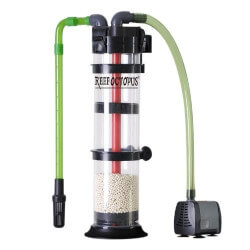
Click here to see the current price + more photos on Amazon.
Here is the good news for those who dislike complications: Reef Octopus Beginner Media Filter 4 Inch Chamber is easy to set up.
Its ease of use combined with its durability and sturdiness classify this unit as probably the best media reactor for GFO and carbon filtration overall.
Personally, I like the fact that it is very large and therefore has ample capacity to hold huge amounts of both GFO and/or carbon media.
You won’t be changing the media here and there, as happens when you have a smaller reactor.
Along with its 4-inch chamber is a pump that works at 95 GPH (gallons per hour) which is quite enough to move large quantities of water a couple of times per day through the tube.
The flow rate is also modest enough not to cause grinding of GFO media while supporting a gentle tumble.
This will save you from having to clutter your sump with more than one pump, though the larger size of the unit somewhat makes up for that.
Another plus is that it comes with all of the necessary fittings like hoses, sponge pads, feed pumps, etc.
You are not going to run up and down looking for these and in my book that saves lots of anxiety.
I really can’t help but appreciate the fact that this is an all-in-one kit.
The Reef Octopus Media Filter is made from durable parts making it a clever long-term choice for an aquarium that tends to experience heavy nutrient pollution.
It can also be used purely as a carbon reactor, as the pump won’t cause the soft carbon granules to grind.
You can hang this unit over rims as large as one inch as per its advertisement.
Definitely buy the Reef Octopus Media Filter if you have a larger aquarium that can become dense on excess nutrients such as an overstocked cichlid tank or an LPS-heavy coral reef tank.
Its robust build and large media capacity are ideal for 75 to 150-gallon aquariums.
Advantages:- It’s an all-in-one kit.
- Robust and durable.
- It’s easy to initially set up and also disassemble for future media changes.
- The instructions are clear enough.
- It has a large canister that’s enough to accommodate more than one media.
- The pump supports the so-needed tumbling of the GFO media granules, without being too weak or too strong.
- Some users report noisiness (this could be human error as not everyone who’s used it complain about this).
- Higher price tag.
3. AquaMaxx Fr-se Hang-on Filter Media Reactor — The High Quality Build.
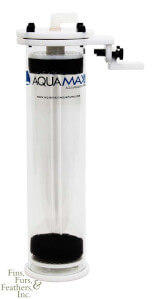
Click here to see the current price + more photos on Amazon.
As its name suggests, this media reactor is easy to attach to your fish tank or sump.
The canister is made of cast acrylic which is a sign that AquaMaxx takes the build of this media reactor very seriously.
The AquaMaxx Fr-se Hang-on Filter Media Reactor is another beneficiary of the efficient up-flow design.
The goal is to always suspend and evenly scatter the filter media to enhance contact with 100% of the aquarium’s water.
The water travels down the filter through the middle internal tube and at the bottom, it gets forced upward directly coming in contact with all the GFO or other media after which it finally gets returned into the tank.
To keep the inlet and outlet intact, a bracket has been designed for the purpose and it seems to me that it works very well in doing so.
As a multi-purpose reactor, you can use it not only for phosphate removal with granules of Ferric Oxide but also with activated carbon and even porous pellets for growing nitrifying bacteria.
According to what I’ve seen you can place both GFO and carbon in the same reactor cartridge without worrying that one will negatively impact the other.
It has a height of slightly more than 14 inches and can hold up to 1 liter of water (1 / 4 gallon), which translates to 4.2 cups.
For effective usage and long-lasting carbon or GFO media, I recommend a flow rate of not more than 150 GPH and a limit of 300 GPH for BioPellets.
- GFO — 150 gallons
- Active carbon — 75 gallons
- BioPellets — 50 gallons
I recommend that you get the AquaMaxx media reactor if you’re having problems with excess phosphate or other inorganic pollutants in small to medium-sized aquariums of up to 100 gallons.
I’ve seen it work best in this range.
Advantages:- Canister is made of cast acrylic.
- It’s easy to hang on your sump or tank.
- As a multi-purpose reactor, you can use it for various media.
- Because of its convenient Hang-On design it suits nano tanks as well.
- Easy and quick disassemble for maintenance.
- Durable.
- It’s not an all-in-one kit
4. Accel Aquatics Biopellet and Filter Media Reactor – Fr-30 – No disassembly required for maintenance
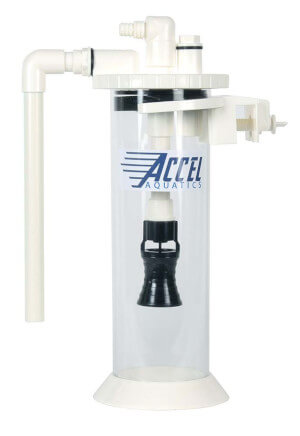
Click here to see the current price + more photos on Amazon.
Although Accel Aquatics Biopellet Reactor was designed with bio-pellets in mind, you can use it to fluidize GFO media for removing phosphate as well.
Using it like this is not very popular, but I’ve found it to work seamlessly as long as it’s executed in the right way.
With this reactor’s design, only a small pump is required to combine efforts with its built-in special eductor.
Let me explain:
This is a unique feature with the Accel Aquatics Filter Media Reactor as it allows for using a very weak pump.
The pump can be no more than 60 GPH in terms of power.
This will save you some money on electricity consumption in the long run, while also lowering the initial costs.
That makes the Accel Aquatics reactor one of the best stuff you can get as a media reactor for Ferric Oxide granules and control over phosphates in terms of efficiency.
Anyhow, the aforementioned ‘special eductor’ is simply a flow accelerator that churns the water with turbulence strong enough to keep the GFO tumbling with no time to settle and clump.
Its inverted, cone-shaped bottom also prevents the media from sinking to the bottom.
This is a proven technology for increasing flow rate, often used outside aquariums, so there’s that.
You should consider a very low-GPH pump in order not to grind the carbon to dust.
Ferric Oxide has harder granules and does not grind as easily.
Anyway, I should point out that Accel Aquatics Biopellet And Filter Media Reactor – Fr-30 is easy to set up and manage.
The inlet is flexible enough to twist to the setting suitable for your fish tank.
Another plus is that adding media is so easy.
You simply open a small screw plug on the top — no need to remove the whole top like with some other reactors.
A friend of mine also bought this a couple of months ago, and she says that so far the unit works like a champ.
I recommend getting the Accel Aquatics BioPellet chamber as a GFO reactor if you’d like to have a super power-efficient solution that can fluidize large quantities of phosphate-absorbing media.
Advantages:- Very easy to set up.
- Maintenance requires almost 0 efforts.
- Well-thought design.
- It requires a small and low-GPH pump to tumble the Granular Ferric Oxide.
- Very energy efficient.
- Large capacity for filter media.
- It does not work well for carbon. Unless you considerably lower the flow, it ends up tumbling into tiny bits.
- You may have to buy tubing and a pump separately.
5. Innovative Marine Minimax Pro Series Media Reactor – Desktop — Best for nano reef tanks

Click here to see the current price + more photos on Amazon.
The Innovative Marine Minimax Pro Series Media Reactor is indeed an innovative product that ensures your aquarium maintains pristine water free of excessive nutrients.
This rather new concept, in a nutshell, reduces the need for typical accessories like ball valves, flexible pipes, PVC pipes, thumb screws, and other usual suspects that should (traditionally) come with your media reactor.
I know I have already discussed the All-in-One concept elsewhere, but with this particular product, it is on a level of its own.
My experience has been that the IM Minimax is one of the best choices you can make when you need a carbon and GFO reactor for a nano reef or other small aquarium.
Some reactors have inner chambers that are difficult to remove, however, with this one the problem is solved.
See, doing regular maintenance is not where I shine because I find it somewhat annoying.
For this reason, I really like that the IM Minimax Reactor has chambers that are very easily removed and taken out.
Another thing I enjoyed about this media reactor is the fact that it is made of acrylic — a bold guarantee that it’s made to last.
The chamber tops and bottoms are crowned in black acrylic while other parts are made of clear acrylic.
I think this may be for aesthetic purposes.
You can easily attach the reactor to the side of your tank because it has downward suction cups.
The pump itself is placed on the bottom of the reactor.
I also want to praise the Innovative Marine’s responsive customer service.
Whenever I have contacted them for any reason, the response has always been fast, the conversation interactive and the assistance helpful.
They value their customers, at least from my experience.
With its dual chambers, you can use this reactor for carbon media and organic absorption, GFO for phosphate filtration, or BioPellets for nitrate control.
The one thing I do want to point out as a con here is that the sponge pads that are originally included in the package won’t do you much good.
They are, in fact, too coarse to not let GFO or carbon particles cloud your sump.
You should get a separate sponge pad that’s finer to be able to hold down the granules instead of shooting them up throughout your aquarium.
However, instead of a sponge, I recommend getting filter floss because it’s probably the cheapest option for that, while its mechanical filtration potential is probably undisputed in the hobby.
Aside from that, the flow of the pump (almost 60 GPH) does require a little fine-tuning, but at the end of the day, it’s pretty doable.
I would recommend getting the Innovative Marine Minimax Pro Media reactor if you’re the owner of a nano tank (anything under 40 gallons) that has issues with phosphate or other inorganic compounds building up.
This unit also has one of the least time-consuming processes for changing filter media.
Advantages:- It operates silently with no micro-bubbles to scare the timid nano fish in your reef tank. This is because the water exits down below the waterline in the rear chamber.
- Changing the media is as easy as ABC.
- Due to its small, compact size, it does not take up much space so it suits smaller nano tanks (it’s a mere 2″ x 2.3″ x 11.75″).
- It is affordable (and a wise-expenditure in the long run).
- The design makes it easy for you to control the flow rate by simply turning a knob.
- The efficient upward flow concept guarantees lower energy consumption (2.5 watts is all it needs).
- It’s easy to clean or maintain; no tools required. The internal chamber automatically drains water out once it slides out of the outer chamber.
- It is made from high-quality material so it can stand the test of time if used properly.
- It contains all the features a media reactor needs, starting with the pump.
- Removing the four sponges in the inner chambers is sometimes quite a struggle, though you can quickly solve this by using slender tongs.
- The flow rate is at times challenging to adjust.
- You should get filter floss to make it work for slow flow rate media.
6. Aquatop Media Reactor – Has its own pump and plumbing
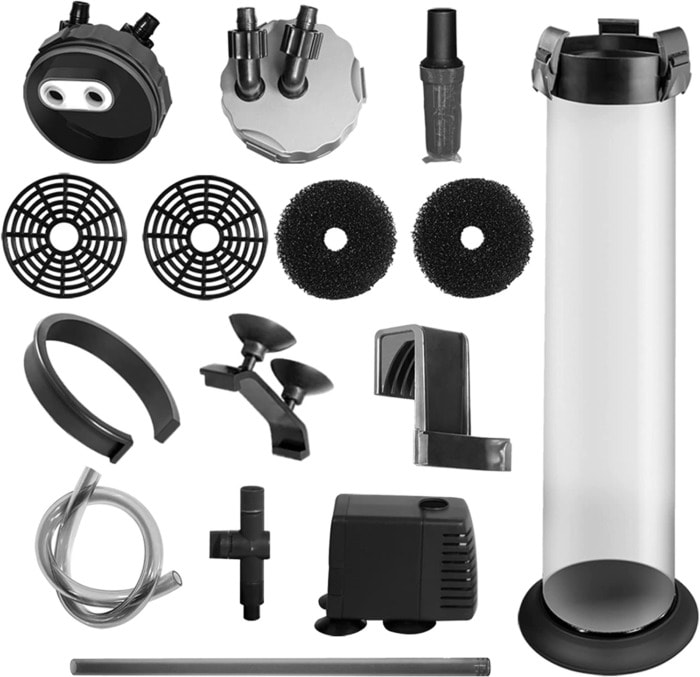
Click here to see the current price + more photos on Amazon.
So when I was initially researching media reactors I did not come across the Aquatop one but that was a long time ago.
In recent years it has been popping up here and there until it finally got popular enough to compel me to try it.
Obviously my first impression of the Aquatop Media Reactor was the decent pricing.
For a GFO reactor of this dimensions it falls on the budget side, which I liked.
Moreover, the thing that really amazed me was that it came with its own pump and plumbing, completing the set.
This is not typical for media reactors and is more than welcome in my book.
The assembly was kind of a figure-it-out-myself process. In fact, when I did finally put it together, I noticed that I did a bad job so I had to disassemble it and do it all over.
Don’t let that scare you though, I was just too concentrated on doing it right the first time and forgot to be careful when plugging the tubes.
The second assembly took very little time for me.
To avoid my mistake, you’d want to just be extra careful when putting the Aquatop media reactor together.
Apart from that, the reactor worked well and my expectations were fulfilled.
The pump is not super strong per se but if you don’t overdo it with the GFO media you will not have issues.
To sum it all up, the Aquatop media reactor is budget-friendly and saves you a bunch of headaches with side equipment such as tubes and pumps.
Because of the pump’s somewhat weaker power you’d want to use this reactor for maybe half of the recommended tank size on the label.
For example, use the “up to 75 gallons” one for 40 to 50-gallon tanks at most.
Advantages:- Easy on the budget
- Comes with its own pump and plumbing
- The size is good
- Assembly is easy in general but it takes some planning beforehand
- Pump may seem somewhat weak to some users but that’s okay if you follow my advice about tank size
- Maybe you should not use it for carbon dosing as it may clog it
Does Buying A Cheap One Mean Lower Quality?
You’ve probably heard the cheap-is-expensive motto, which insinuates that a comparatively cheap product is of low quality, is soon worn-out, and therefore of little value in the long run.
I think it’s true to some extent but probably not when it comes to media reactors.
Here is why buying a cheap media reactor does not mean lower quality:
If a media reactor is cheap that simply means it does not come with all the side equipment or that it’s a smaller size.
For example, it may come without a pump, double chambers, or tubes.
Furthermore, some are designed specifically for particular types of media.
This has absolutely nothing to do with the quality.
At the end of the day, you get back value for the money you spend on a media reactor, be it cheap or expensive.
Best Granular Ferric Oxide Media to Remove Phosphate and Other Pollution?
So far, I have mainly discussed the media reactors, but for optimal performance, you’d need to use the right kind of filter media.
I have personal experience with all of the products mentioned below which makes it fairly easy to point you to the right one for your setup.
It’s worth noting that pH and salinity can alter their phosphate-absorbent capabilities to a degree.
Take a look at the best GFO media for removing aquarium phosphates:
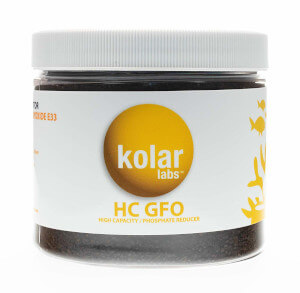
1. Kolar Labs GFO HC – High Capacity Bayoxide E33HC Phosphate Remover
Click here to see the current price + more photos on Amazon.
This GFO is so strong that it’s used to fight algae in commercial swimming pools and ponds.
Its high capacity (it’s 4 times more effective compared to most GFOs) will ensure your tank is considerably free from surplus phosphate within 24 to 48 hours.
It’s best for high-end aquariums with heavy bio-load.
Using high-capacity GFO media has one major advantage over regular ferric oxide granules:
Less quantity means easier control over the “tumbling” and the media not solidifying for longer periods of time.
Using lots of granules will make it difficult to distribute an even flow rate through the whole thing.
You may get strong grinding at the bottom and no movement at all on top of the media.
I like it because it never discolors the water in spite of its high concentration.
It also has little to no dust, so not much rinsing is needed.
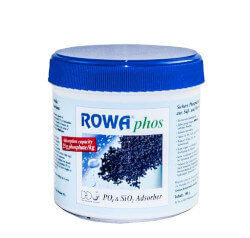
2. D-D Rowahos Phosphate Remover for Aquarium
Click here to see the current price + more photos on Amazon.
This attests to its popularity.
I first used it years back when I was just starting out.
My tank had a huge outbreak of algae which was taken care of fairly easily, but the more important thing is it never came back.
My experience with this Phosphate remover has been that it definitely does the job.
One con to mention is that you will need to use finer pads or sponges for blocking it because the D-D Rowahos Phosphate Remover has a rather small grain size.
Aside from that, make sure to rinse super well before use.
I recommend giving this GFO a try.
It’s a solid choice for keeping all types of algae at bay and that’s not just my opinion.

3. Kolar Labs GFO Bayoxide E33 Phosphate Remover
Click here to see the current price + more photos on Amazon.
I’m including this because of its value for the money ratio.
You will like this one for its affordability and strength.
That’s the best-case scenario though, so don’t let yourself go with the maintenance.
It will not perform as well as the above two, but it still is a very efficient way to fight hair and other types of algae outbreaks.
I recommend getting the normal capacity Kolar Labs GFO Bayoxide E33 if you’re on a budget and you want to get the best bang for your buck.
Should You Get A Pump, And What Brand Would Work Best For Your Reactor?
Since buying a media reactor is not the only piece of equipment for a full set of pollutant removal in the aquarium I’ll give you a quick recommendation on pumps as well.
If you are going to purchase (or already have) a media reactor without a pump, you obviously need one to force the water through the media.
Here is the best pump for a GFO reactor:
The Sicce Syncra 0.5 Aquarium Pump, 185 GPH, is so quiet you could think it is off or out of order just when it’s at the top of its game. It’s fairly priced for the GPH it provides and most importantly – it has the adjustable flow rate feature.
For the best results, you need to tune it down a little because 185 gallons per hour is still high for most GFO media.
It’s not a strong machine per se, but it’s the ideal pump for your carbon or GFO media reactor because it can easily support a gentle tumble when needed.
How to Properly Have both GFO and activated Carbon in the Same Canister?
Perhaps, you’ve noticed that I did not recommend getting a dual-canister media reactor anywhere in this article.
Most sellers will try to convince you that if you’re about to run both GFO and carbon media, you’ll need separate canisters because the GFO lasts much longer than the carbon media.
It’s true that they have a very different lifespan when put to use.
Here’s how to separate GFO from carbon in a single reactor’s canister:
What you can do is simply getting some filter floss to separate the media and put the carbon above the GFO. The filter floss will keep things in place, and since the carbon is placed to the top of the canister where the lid is, you can change it easily without having to remove the GFO along the way.
Since activated carbon lasts fairly short compared to the Ferric Oxide granules you’d want to position it in such a way that you could change it more often, without disturbing the GFO.
That being said, you can actually mix both.
The advantage here is that the carbon will separate the Ferric Oxide granules, preventing them from solidifying.
A disadvantage to this method is that you’ll likely need to change the mix before the GFO’s filtering capacity has expired.
Here is how to mix GFO and carbon media in the same reactor’s chamber:
Mix the activated carbon in a ratio of 4 times carbon to 1 time GFO.
That is, carbon should be around 80% of the mixture.
This is because carbon normally breaks down fast during tumbling and so runs out ahead of GFO.
It’s important to make sure there’s no tumbling when the two are mixed because the Ferric Oxide granules are way harder than the carbon.
If there’s tumbling present the GFO media will grind the softer carbon to dust.
Tumbling is only necessary when GFO is on its own and so could clump and settle to the bottom if not stirred.
However, when mixed in the same reactor with activated carbon, its ability to clump is almost non-existent.
Generally, when calculating the exact amount of GFO your reef or freshwater aquarium needs you first need to take into consideration what type of GFO you’ll be using.
- High-capacity GFO media – 1 tablespoon per 8 US gallons or 30 liters of water.
- Regular GFO media – 1 tablespoon per 4 US gallons or 15 liters of water.
FAQs
What is the best one for removing Phosphate from your aquarium?
This essentially depends on the quality of Granular Ferric Oxide that you’re using and the build of your Phosphate reactor. It’s always a good idea to use premium GFO media. The reactor itself should have a pump that is able to send water through its chamber at the right flow rate. The design of the chamber should also allow that flow to be evenly distributed throughout it. Any pump that allows for fine-tuning of the flow rate is a good option here. The best flow rate for most phosphate reactors is between 120 and 150 gallons per hour (GPH).
How long does GFO last in one?
Generally speaking, GFO media lasts between 4 and 8 weeks. After that you’d want to replace it or you’ll see Phosphate levels in your reef tank rising again.
Should GFO tumble in one?
Ideally, you’d want your GFO to tumble in the reactor. If it does not gently tumble, the ferric oxide will clump together. Clumping significantly reduces the area of the Ferric Oxide that’s exposed to water, which reduces how well it filters out Phosphates. If you can’t make yours tumble you should periodically stir it, which can be time-consuming.
Can you run Carbon and GFO media in the same one?
Yes, you can run both in the same chamber. You can do that by “dividing” them with a layer of filter floss, with the Carbon media being above and close to the lid. This is because Carbon runs out a lot quicker than GFO media, so you’d want to be able to replace it without disturbing the Ferric Oxide. The other option to run both in the same reactor chamber is to mix them in a 4:1 Carbon to GFO ratio. If they’re mixed, you don’t need them to tumble.
My Final Thoughts

Having read this guide, you are in a better position to decide which product would suit your carbon or Granular Ferric Oxide of choice for freeing your aquarium of algae.
Consider what you most value in a unit and let that, along with your budget decide which GFO reactor should best fit your particular setup.
Drop me a comment below to tell me what you chose and how it’s been working for you.






